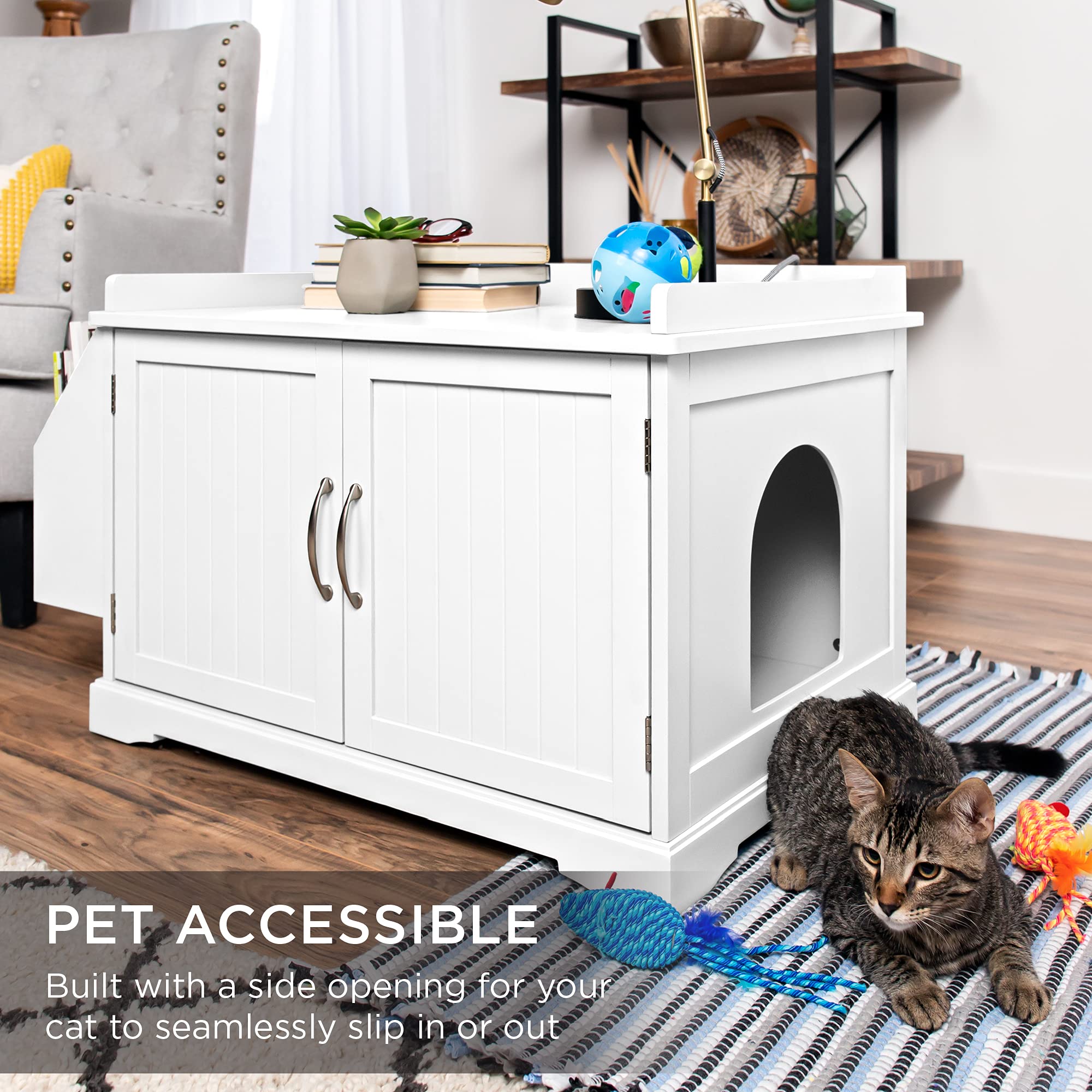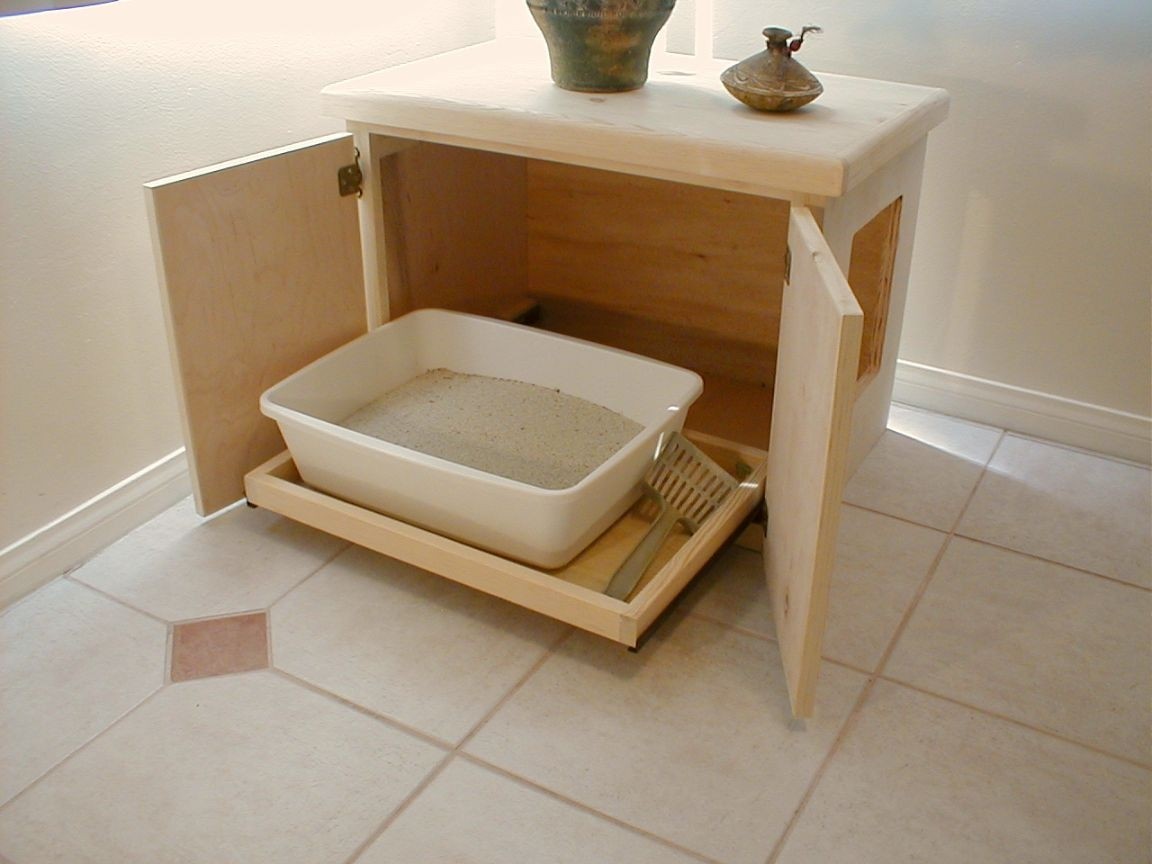Top Entry Litter Box Cabinet Benefits and Features

Tired of the constant odor and unsightly mess that comes with a traditional litter box? A top entry litter box cabinet can be the perfect solution! These innovative cabinets offer a discreet and hygienic way to manage your cat’s bathroom needs, while also enhancing the aesthetic appeal of your home.
Advantages of Top Entry Litter Boxes
Top entry litter boxes offer several advantages over traditional litter boxes. The enclosed design significantly reduces odor and mess, making them a great choice for cat owners who want to keep their homes smelling fresh and clean.
- Odor Control: The enclosed design traps odors inside the cabinet, preventing them from escaping into the surrounding environment. This is especially beneficial for homes with multiple cats or for those who live in smaller spaces.
- Reduced Mess: The top entry design makes it difficult for litter to scatter outside the box. This reduces the amount of time you spend cleaning up litter spills and keeps your floors cleaner.
- Ease of Cleaning: Top entry litter boxes are generally easier to clean than traditional boxes. The enclosed design makes it easier to remove the litter box and dispose of the waste, and the cabinet itself can be easily wiped down.
Features of Top Entry Litter Box Cabinets
Top entry litter box cabinets come in a wide range of sizes, materials, and designs to suit different needs and preferences. Here’s a closer look at some of the key features to consider:
Size
The size of the cabinet is an important consideration, as it should be large enough to accommodate your cat’s litter box and provide ample space for them to move around comfortably. Consider the size of your cat and the type of litter box you plan to use when choosing a cabinet.
Materials
Top entry litter box cabinets are typically made from wood, plastic, or metal. Wood cabinets offer a classic and elegant look, while plastic cabinets are more affordable and easy to clean. Metal cabinets are durable and long-lasting but can be more expensive.
Storage Options
Many top entry litter box cabinets include storage options, such as shelves, drawers, or compartments. These can be used to store cat food, toys, cleaning supplies, or other essentials.
Design Aesthetics
Top entry litter box cabinets are available in a variety of styles and designs to complement any home decor. Some cabinets feature sleek and modern designs, while others have a more traditional or rustic look.
Innovative Features
Some top entry litter box cabinets feature innovative features that enhance the user experience, such as:
Self-Cleaning Mechanisms
Some top entry litter box cabinets include self-cleaning mechanisms that automatically remove waste, reducing the need for manual cleaning. These mechanisms typically use a rake or scoop to collect the waste and deposit it into a separate container.
Odor Filters
Odor filters can be incorporated into the cabinet design to further enhance odor control. These filters trap odor molecules and prevent them from escaping into the surrounding environment.
Automatic Litter Refills
Some top entry litter box cabinets have automatic litter refill systems that automatically dispense fresh litter as needed. This eliminates the need to manually refill the litter box, saving you time and effort.
Choosing the Right Top Entry Litter Box Cabinet

Selecting the perfect top entry litter box cabinet for your feline friend requires careful consideration of several factors. This ensures that the cabinet meets your cat’s needs and seamlessly integrates into your home.
Cat Size and Weight
The size and weight of your cat play a crucial role in determining the appropriate dimensions of the cabinet. A spacious cabinet allows for comfortable movement and minimizes the risk of litter scattering.
- Small to Medium Cats: For cats weighing up to 10 pounds, a cabinet with an opening of 12 inches by 12 inches is generally suitable.
- Large Cats: Larger breeds, such as Maine Coons or Persians, may require an opening of 14 inches by 14 inches or even larger.
Litter Type
The type of litter you use can influence your cabinet choice.
- Clumping Litter: Clumping litter requires a cabinet with a scoop holder or a removable tray for easy scooping and disposal.
- Non-Clumping Litter: For non-clumping litter, a cabinet with a larger waste drawer or a more frequent cleaning schedule may be necessary.
Space Constraints
Consider the available space in your home before purchasing a cabinet. Measure the area where you plan to place the cabinet to ensure it fits comfortably.
- Limited Space: For smaller spaces, a slim cabinet with a compact footprint is ideal.
- Larger Spaces: If space is not a concern, you can opt for a larger cabinet with additional storage features.
Budget, Top entry litter box cabinet
Top entry litter box cabinets come in a wide range of prices, depending on materials, features, and brand.
- Budget-Friendly: Plastic cabinets are generally the most affordable option, offering basic functionality.
- Mid-Range: Wood cabinets provide a more elegant look and are often equipped with additional features like shelves or drawers.
- High-End: Metal cabinets, while durable and stylish, are typically the most expensive option.
Materials
The material of the cabinet affects its durability, aesthetics, and price.
- Wood: Wood cabinets offer a classic and elegant look, but they may be more susceptible to scratches and water damage.
- Plastic: Plastic cabinets are lightweight, affordable, and easy to clean. However, they may not be as durable as wood or metal.
- Metal: Metal cabinets are highly durable and resistant to scratches and moisture. They often come in sleek and modern designs.
Top Entry Litter Box Cabinet Installation and Maintenance

Installing a top entry litter box cabinet is a relatively straightforward process, but proper placement and maintenance are crucial for optimal functionality and your cat’s satisfaction. Here’s a detailed guide to help you through the process.
Installation Process
Installing a top entry litter box cabinet typically involves assembling the cabinet structure and placing it in a suitable location.
- Unpack and Review Instructions: Begin by carefully unpacking all components and reviewing the manufacturer’s instructions. Familiarize yourself with the parts and assembly steps before starting.
- Assemble the Cabinet: Follow the provided instructions to assemble the cabinet structure. This may involve connecting panels, attaching doors, and securing shelves. Most cabinets are designed for easy assembly with minimal tools.
- Install the Litter Box: Place the litter box inside the cabinet. Ensure it fits snugly and securely. Some cabinets may have a dedicated space or a specific way to attach the litter box.
- Choose a Suitable Location: Select a location that is accessible to your cat, away from high-traffic areas and drafts. Consider factors like privacy, lighting, and proximity to food and water sources.
- Level and Secure the Cabinet: Once you’ve chosen the location, ensure the cabinet is level and secure. This may involve using shims or adjusting the feet. Secure the cabinet to the wall or floor if necessary, especially if you have energetic cats.
Maintenance and Cleaning
Regular cleaning is essential for maintaining a hygienic environment for your cat and preventing odor buildup.
- Daily Litter Box Cleaning: Scoop out solid waste daily to prevent odor and keep the litter box clean. This is crucial for maintaining hygiene and encouraging your cat to use the box.
- Weekly Cabinet Cleaning: Clean the cabinet thoroughly at least once a week, using a mild detergent and water. Wipe down all surfaces, including the litter box, to remove dust, hair, and debris. Avoid harsh chemicals that could irritate your cat.
- Deep Cleaning: Perform a deep clean of the cabinet and litter box every few months. This may involve removing the litter box, washing it with soap and water, and cleaning the cabinet interior with a disinfectant.
Encouraging Cat Acceptance
Transitioning your cat to a new litter box can take time and patience.
- Gradual Introduction: Allow your cat to explore the cabinet and litter box at their own pace. Initially, keep the old litter box available and gradually transition to the new one.
- Positive Reinforcement: Reward your cat with treats or praise when they use the top entry litter box cabinet. This helps associate the new box with positive experiences.
- Consider Cat Preferences: Some cats prefer certain types of litter or litter box placement. Experiment with different litter options and adjust the cabinet’s location if needed.
Top entry litter box cabinets offer a discreet and convenient solution for cat owners, concealing the litter box while maintaining easy access for feline companions. The concept of open shelving, as detailed in this guide on removing cabinet doors for open shelving , could be applied to a top entry litter box cabinet to create a more visually appealing and accessible space for both the cat and the owner.
This modification would allow for easy monitoring of litter levels and prompt cleaning, while also offering a more integrated aesthetic within the home environment.
Top entry litter box cabinets offer a discreet and convenient solution for cat owners, effectively concealing the litter box while maintaining easy access for feline companions. This concept of concealing functionality behind an aesthetically pleasing facade is mirrored in the design of a medicine cabinet with sliding mirror doors , where essential items are stored behind a seamless mirror surface.
Similarly, top entry litter box cabinets seamlessly blend into the surrounding decor, creating a clutter-free and visually appealing environment.
